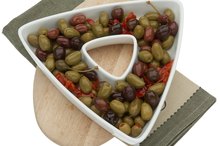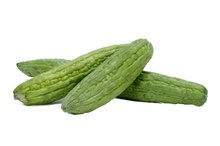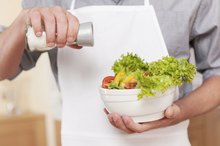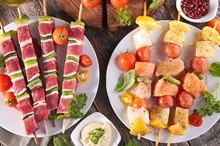What does fact checked mean?
At Healthfully, we strive to deliver objective content that is accurate and up-to-date. Our team periodically reviews articles in order to ensure content quality. The sources cited below consist of evidence from peer-reviewed journals, prominent medical organizations, academic associations, and government data.
The information contained on this site is for informational purposes only, and should not be used as a substitute for the advice of a professional health care provider. Please check with the appropriate physician regarding health questions and concerns. Although we strive to deliver accurate and up-to-date information, no guarantee to that effect is made.
Olive Potassium Levels
Because potassium is necessary for critical life functions, including powering your heart, you need a lot of the mineral in your diet. Olives do give you some potassium, although you’ll only get a trace amount. If you eat a lot of olives, you could actually be doing more harm than good. Olives are loaded with sodium, which can be dangerous for your health in high amounts.
Functions of Potassium
Electrolytes, such as potassium, balance fluids in your body. They ensure that the pressure of fluid in and around all cells is always consistent. Potassium works with other electrolytes to conduct electrical impulses from cell to cell. This function is essential for making your heart beat, transmitting brain messages and for allowing your muscles to contract. Even your metabolism relies on potassium to activate certain enzymes.
- Electrolytes, such as potassium, balance fluids in your body.
Potassium in Olives
Are Olives Good for the Kidneys?
Learn More
Ripe canned black olives are very low in potassium. A 3 1/2-ounce portion, which is about 6 1/2 super colossal olives, 12 jumbo olives, 23 large olives or 31 small olives, provides less than 10 milligrams. A similar-sized portion of canned green olives, or around 37 olives, has slightly more than 40 milligrams of potassium.
- Ripe canned black olives are very low in potassium.
- A similar-sized portion of canned green olives, or around 37 olives, has slightly more than 40 milligrams of potassium.
Your Potassium Needs
The Food and Nutrition Board of the Institute of Medicine recommends people age 14 and older get 4,700 milligrams of potassium every day 1. The recommendation doesn’t change based on gender, pregnancy status or aging. However, if you are a woman who is breast-feeding, you’ll have to temporarily increase your potassium intake to 5,100 milligrams daily. Even if you had a serving of green olives, which have more potassium, you’ll still get less than 1 percent of your recommendation.
- The Food and Nutrition Board of the Institute of Medicine recommends people age 14 and older get 4,700 milligrams of potassium every day 1.
- However, if you are a woman who is breast-feeding, you’ll have to temporarily increase your potassium intake to 5,100 milligrams daily.
Sodium Considerations
Does Potassium Aid in Weight Loss?
Learn More
Olives are canned in a salty solution to help with preservation. High intakes of sodium can throw off your potassium balance, increase your risk of high blood pressure and eventually lead to kidney and heart disease. Limit yourself to no more than 2,300 milligrams of sodium daily, states the Dietary Guidelines for Americans 2010 6. If you’re in the habit of popping a handful of olives in your mouth, you’re probably getting way more sodium than you are aware of. Ripe canned black olives contain 735 milligrams of sodium per 3 1/2-ounce portion. The same portion of green olives has more than double that amount. That’s roughly 65 percent of your sodium allowance for the entire day.
- Olives are canned in a salty solution to help with preservation.
- Limit yourself to no more than 2,300 milligrams of sodium daily, states the Dietary Guidelines for Americans 2010 6.
Related Articles
References
- Linus Pauling Institute: Potassium
- USDA National Nutrient Database: Olives, Ripe, Canned (Jumbo-Super Colossal)
- USDA National Nutrient Database: Olives, Ripe, Canned (Small-Extra Large)
- USDA National Nutrient Database: Olives, Pickled, Canned or Bottled, Green
- USDA National Nutrient Database: Oil, Olive, Salad or Cooking
- U.S. Department of Agriculture and U.S. Department of Health and Human Services: Dietary Guidelines for Americans 2010
- Olives, green. FoodData Central. U.S. Department of Agriculture. Published April 1, 2020.
- Olives, black. FoodData Central. U.S. Department of Agriculture. Published April 1, 2020.
- Omar SH. Oleuropein in olive and its pharmacological effects. Sci Pharm. 2010;78(2):133-54. doi:10.3797/scipharm.0912-18
- Schwingshackl L, Hoffmann G. Monounsaturated fatty acids, olive oil and health status: a systematic review and meta-analysis of cohort studies. Lipids Health Dis. 2014;13:154. doi:10.1186/1476-511x-13-154
- Montoro BP, Benomar N, Lavilla Lerma L, Castillo Gutiérrez S, Gálvez A, Abriouel H. Fermented Aloreña table olives as a source of potential probiotic strains. Front Microbiol. 2016;7:1583. doi:10.3389/fmicb.2016.01583
- La Fata G, Weber P, Mohajeri MH. Effects of vitamin E on cognitive performance during ageing and in Alzheimer's disease. Nutrients. 2014;6(12):5453-5472. Published 2014 Nov 28. doi:10.3390/nu6125453
- Omar SH. Mediterranean and MIND diets containing olive biophenols reduces the prevalence of Alzheimer's disease. Int J Mol Sci. 2019;20(11). doi:10.3390/ijms20112797
- McMacken M, Shah S. A plant-based diet for the prevention and treatment of type 2 diabetes. J Geriatr Cardiol. 2017;14(5):342-354. doi:10.11909/j.issn.1671-5411.2017.05.009
- Esteve C, Montealegre C, Marina ML, García MC. Analysis of olive allergens. Talanta. 2012;92:1-14. doi:https://doi.org/10.1016/j.talanta.2012.01.016
- Tang S, Avena-Bustillos RJ, Lear M, et al. Evaluation of thermal processing variables for reducing acrylamide in canned black ripe olives. J Food Engineer. 2016;191:142-130. doi:10.1016/j.jfoodeng.2016.07.011
Writer Bio
Melodie Anne Coffman specializes in overall wellness, with particular interests in women's health and personal defense. She holds a master's degree in food science and human nutrition and is a certified instructor through the NRA. Coffman is pursuing her personal trainer certification in 2015.









